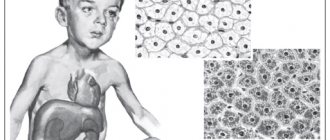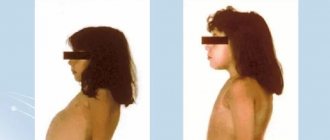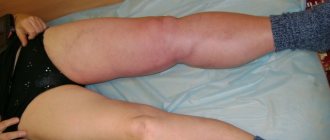A rare medical textbook that mentions the thyroid gland does not include a photograph of a patient with a large mass in the neck and bulging eyes - a classic portrait of a person suffering from diffuse toxic goiter, or Graves' disease.
It is one of the best known endocrine diseases and the most common cause of thyrotoxicosis. It affects 1% of all women and 0.1% of men [1]. Graves' disease, or Graves' disease, or diffuse toxic goiter (DTZ), is an autoimmune organ-specific disease caused by hypersecretion of thyroid hormones. The term “diffuse toxic goiter” is accepted in Russian endocrinology, the name “Graves’ disease” is used in English-speaking countries, and “Bazedow’s disease” or “Bazedow’s syndrome” is used in German-speaking countries.
This disease was first described in 1835 by Irishman Robert James Graves (1797–1853). Almost simultaneously with him, in 1840, the German physician Karl Adolf von Basedow (1799–1854) described the so-called Merseburg triad he observed in four patients (named after the city of Merseburg, where he worked) - tachycardia, exophthalmos and goiter, which are characteristic DTZ symptoms. Bazedov himself called the disease he described exophthalmic cachexia.
Classification and severity of diffuse toxic goiter
Clinical guidelines for the diagnosis, treatment and prevention of Graves' disease offer several options for its classification:
- according to O. V. Nikolaev;
- recommended by the World Health Organization (WHO);
- according to the severity of thyrotoxicosis - options I and II.
Classification of Graves' disease according to O. V. Nikolaev
| Degree | Characteristic |
| 0 | The thyroid gland is not detectable on palpation |
| I | On palpation, an enlarged isthmus of the thyroid gland is felt |
| II | Enlargement of the lateral lobes of the gland, determined by palpation |
| III | Visual enlargement of the thyroid gland – “thick neck” |
| IV | Clearly visible goiter (significant enlargement of the gland) |
| V | Huge size goiter |
This classification has advantages over the one proposed by WHO, since it contains more degrees of gradation of the disease, which allows clinicians to apply more precise treatment prescriptions at each stage.
WHO recommended classification
| Degree | Characteristic |
| 0 | There is no goiter, the volume of each lobe of the thyroid gland is no more than the volume of the distal phalanx of the patient’s thumb |
| I | The goiter is not determined visually, but can be felt by palpation. There may be nodes that do not increase the volume of the gland |
| II | Clearly visible goiter with normal neck position |
Classification according to the severity of thyrotoxicosis: option I
Depending on the extent of damage to the thyroid gland and the existing symptoms, there are three degrees of severity of the disease:
- mild - decreased performance, tachycardia - increased heart rate (HR) up to 100 beats per minute (bpm), decreased body weight by 10-15%;
- medium – characterized by high nervous excitability, heart rate reaches 100-120 beats per minute, weight loss exceeds 20%;
- severe - tachycardia over 120 beats/min, weight loss may exceed more than half of the initial body weight, severe complications appear, leading to complete loss of ability to work.
Classification according to the severity of thyrotoxicosis: option II
Proposed in 2007 by V.V. Fadeev and G.A. Melnichenko. Like option I, it is based on the severity of clinical manifestations and hormonal disorders. Takes into account the content of thyroid hormones in the blood.
Subclinical thyrotoxicosis (mild degree). It is characterized by the absence of clinical symptoms or their erased manifestations. The content of thyroid-stimulating hormone (TSH) is reduced, the content of free (free) T4 and free (free) T3 is within normal limits.
Manifest thyrotoxicosis (moderate). It is described by a developed clinical picture, a significantly reduced TSH content, an increased concentration of St. T4 and St. T3.
Complicated thyrotoxicosis (severe). Severe combined symptoms, psychotic phenomena, sharp loss of body weight. The TSH content is significantly lower than normal, the concentration of St. T4 and T3 are elevated.
Treatment of diffuse toxic goiter
There are many ways to treat Graves' disease, and the specific method is selected depending on the clinical situation. The methods are:
- conservative treatment;
- surgery;
- use of radioactive iodine;
- computer reflexology.
Each of these methods has its pros and cons, indications and contraindications. The attending physician decides which method to use, depending on the patient’s general condition, length of illness, presence or absence of complications, age and gender, and the presence of concomitant diseases.
Causes of Graves' disease
Graves' disease is an autoimmune disease . In this condition, autoimmune aggression occurs - the immune system, under the influence of certain factors, begins to produce antibodies that act on target organs. First of all, this is the thyroid gland, which in response begins to produce hormones in the wrong way.
The main cause of DTD is genetic predisposition. In most cases, it is ethnically associated - the haplotypes responsible for the development of the disease are found in people of the European race.
Despite the fact that the characteristics of the immune response can be inherited, they are not always realized. Provoking factors may be excess iodine, stress, smoking, bacterial or viral infections. Stress factors play a special role in triggering the mechanisms of the disease; smoking increases the risk of developing Graves' disease by 1.9 times. Some scientific studies put forward a theory about the molecular mimicry (similarity) of thyroid antigens with the antigens of some bacteria. Source: About Graves' or Graves' disease. Botkin S.P. Endocrinology: News. Opinions. Training, 2013. p. 25-36.
Diffuse toxic goiter can occur against the background of other autoimmune pathologies of the endocrine system - type I diabetes mellitus, primary hypocortisolism.
Etiology and pathogenesis
The mechanism of development of Graves' disease is based on the production of autoantibodies to receptors of the plasma membranes of thyrocytes, close to thyrotropin receptors. These antibodies are called thyroid-stimulating immunoglobulins. The cause of their formation is unclear (as the causes of other autoimmune diseases are unclear). It is believed that the trigger mechanism can be mental trauma, allergic reactions, and inflammatory diseases, but the main role in the pathogenesis is played by congenital immunological deficiency associated with hereditary factors.
Genetic studies show that if one of the monozygotic twins suffers from Graves' disease, the other has a 60% risk of the disease; in the case of dizygotic couples, this risk is only 9% [4].
Diffuse toxic goiter is often combined with other autoimmune diseases [4]. More often, young and middle-aged women suffer from it. It is interesting that the antibodies produced during DTD have a stimulating, rather than destructive, effect on the target organ, as in other autoimmune processes. Constantly being in a state of increased activity, the thyroid gland produces an excess amount of thyroid hormones. As a rule (but not always), this leads to its diffuse increase and the development of ophthalmopathy. The clinical manifestations of Graves' disease are determined by thyrotoxicosis, a syndrome that is caused by a prolonged increase in the concentration of thyroid hormones in the blood and tissues.
Since thyroid hormones take part in regulating the functions of almost all body systems, an increase in their concentration has a negative effect on many organs and systems. In general, we can say that with thyrotoxicosis all metabolic processes are accelerated.
Symptoms of the disease
The symptoms of thyroid disease are caused by increased production of thyroid hormones, which affect almost the entire human body. The main signs of Graves' disease are symptoms of thyrotoxicosis, which can be divided into groups depending on which system they affect. Source: Morphological criteria for the diagnosis of diffuse toxic goiter. Botasheva V.S., Elkanova A.B., Lavrinenko A.A. Medical and pharmaceutical journal “Pulse”, 2021. p. 6-11.
Symptoms from the central and peripheral nervous system:
- irritability, excitability, fussiness, tearfulness, sleep disturbances;
- Marie's symptom - tremor (shaking) of outstretched fingers;
- “telegraph pole” symptom – tremor of the whole body;
- increased tendon reflexes;
- sometimes – the development of thyrotoxic psychosis.
Symptoms of damage to the cardiovascular system:
- sinus tachycardia, increased heart rate;
- increased systolic (upper) blood pressure and decreased diastolic (lower);
- increased pulse pressure (difference between systolic and diastolic);
- in severe cases of the disease - atrial fibrillation or its paroxysms;
- myocardial dystrophy, the occurrence of circulatory failure.
Symptoms that appear when the gastrointestinal tract is damaged:
- increased appetite;
- frequent loose stools;
- liver dysfunction up to thyrotoxic hepatosis.
Symptoms of damage to other endocrine glands:
- ovarian dysfunction, menstrual irregularities, decreased libido in women;
- gynecomastia and potency disorders in men;
- relative adrenal insufficiency;
- impaired glucose tolerance, causing type II diabetes mellitus.
Ectodermal disorder syndrome:
- brittle nails;
- splitting and hair loss;
- itchy skin, hot, moist to the touch skin;
- appearance of vitiligo.
Hypermetabolism (accelerated metabolism):
- progressive weight loss due to increased appetite;
- feeling of heat, low-grade body temperature;
- myasthenia gravis (muscle weakness), adynamia;
- osteoporosis.
The presence of a goiter is an important sign of Graves' disease, which is present in almost all patients, but the severity of this symptom varies, and the severity of the disease does not depend on the size of the goiter.
Endocrine ophthalmopathy (EOP) is another sign of DTZ. In most cases, it appears about a year later than thyrotoxicosis syndrome and has varying degrees of severity.
EOP symptoms:
- exophthalmos (bulging eyes), often asymmetrical;
- sparkle of eyes;
- rare blinking;
- photophobia, lacrimation, pain and burning in the eyes;
- swelling and pigmentation of the eyelids;
- diplopia (doubling of the image) when looking up or to the side.
In rare cases, in 3-4% of patients, with Graves' disease, pretibial myxedema develops - one- or two-sided, clearly defined, purplish-bluish compaction on the anterior surface of the leg, affecting the skin and subcutaneous fat.
In children, DTG develops acutely, in elderly patients it is more often asymptomatic or with mild symptoms. In women, a severe form of the disease prevents pregnancy and increases the risk of miscarriage and stillbirth.
How does thyrotoxicosis manifest itself and why is it dangerous?
Several symptoms of thyrotoxicosis dominate. The most typical symptoms are weight loss, rapid pulse with an unpleasant feeling of palpitations, muscle weakness, and fatigue. Thyrotoxicosis is dangerous due to severe changes, primarily in the heart. If it is not treated for a long time, dystrophic changes develop in the heart muscle, which are manifested by rhythm disturbances, and subsequently by heart failure. In addition, persistent changes develop in the central nervous system, bones, liver and other organs; Against this background, the functioning of the reproductive system is disrupted.
Complications of Graves' disease
With late diagnosis and the absence of adequate therapy, DTD leads to irreversible damage to all organs and complete disability of the body. A fatal outcome due to dysfunction of the cardiovascular system and severe arrhythmia cannot be ruled out. The disease can cause the following complications:
- osteoporosis;
- diabetes mellitus type II;
- thyrotoxic hepatosis.
The most serious complication of Graves' disease is thyrotoxic crisis. It can develop as a result of stress, concomitant diseases, surgical treatment, severe physical activity, or sudden climate change. The condition requires urgent care.
Symptoms of thyrotoxic crisis:
- sudden excitement;
- increase in body temperature up to 40° C;
- increase in heart rate to 200 beats per minute;
- increased pulse pressure;
- atrial fibrillation;
- adrenal insufficiency - hyperpigmentation, thread-like pulse, microcirculation disorders.
Thyrotoxic crisis
The most dangerous complication of thyrotoxicosis is thyrotoxic crisis. This is an acutely developing clinical syndrome, which is a combination of thyrotoxicosis with thyrogenic adrenal insufficiency.
Thyrotoxic crisis develops against the background of inadequate thyreostatic therapy after surgery and in acute extrathyroidal diseases. The reasons for its occurrence are not well understood. Patients with thyrotoxic crisis are subject to observation and treatment in the intensive care unit.
Clinically, a thyrotoxic crisis is manifested by a sharp increase in the symptoms of thyrotoxicosis with progressive dysfunction of the cardiovascular system, gastrointestinal tract, central nervous system, liver and kidneys. Hyperthermia up to 40 °C, tachycardia, depression of consciousness up to coma are noted. Thyrotoxic coma is almost always fatal. In addition, extremely difficult to correct acute cardiovascular failure often develops, which is the most severe complication of thyrotoxic crisis. Mortality during thyrotoxic crisis reaches 75% [3].
Patients with thyrotoxicosis are often very popular with people of the opposite sex, unless, of course, changes in their appearance and behavior are moderate and are not perceived by non-medics as painful. I remember how a patient, whose symptoms went away due to successful treatment, complained to me that before she had never stopped seeing fans, but now the sparkle in her eyes was gone, and with it her sexual attractiveness...
Diagnostics of DTZ
The diagnostic plan for diffuse toxic goiter includes the following activities:
- taking anamnesis;
- general examination – condition of the skin, hair, nails, presence of hand tremors;
- physical examination – measurement of weight, height, blood pressure, pulse rate;
- examination and palpation of the thyroid gland;
- ophthalmological examination;
- Ultrasound or MRI of the thyroid gland;
- laboratory tests - general analysis and blood biochemistry, determination of TSH content, st. T3, St. T4, pituitary hormones, titer of antibodies to the TSH receptor, titer of “classical” antibodies to the thyroid gland;
- additional examination methods (according to indications) - electrocardiography, isotope scintigraphy, fine-needle puncture biopsy of the thyroid gland. Source: Diagnosis and treatment of Graves' disease. Fadeev V.V. Medical Council, 2014. p. 44-48.
Prevention
To prevent the development of Graves' disease, you need to maintain a correct lifestyle and avoid stress. It is very important to follow these rules for women during menopause , when the risk of hormonal imbalances increases. Patients with Graves' disease should not be exposed to the sun, swim in the sea, or take hydrogen sulfide baths. You should always try to maintain peace of mind and periodically visit sanatoriums with specialized treatment. The patient's diet should be sufficiently high in calories, with a large amount of carbohydrates. It is important to limit animal proteins in the diet, and also rarely consume foods that have a stimulating effect on the body (tea, coffee, spicy foods, etc.). It is worth eating foods containing iodine: seaweed, seafood, vegetables and fruits.
Treatment of Graves' disease
Patients with Graves' disease are supervised by a general practitioner or endocrinologist. Diffuse toxic goiter is treated in three ways:
- drug therapy with thyreostatic drugs;
- radioiodine therapy;
- surgical treatmentSource: Treatment tactics for diffuse toxic goiter. Bebezov B.Kh., Iuraliev M.A., Kakcheeva T.T., Salieva B.E., Chazymov R.M. Clinical medicine, 2013. p. 61-67.
Thyrostatic drugs for the treatment of diffuse toxic goiter are prescribed if the volume of the thyroid gland does not exceed 40 cubic meters. cm, there are no signs of compression of surrounding tissues and large nodes in the gland, there are no complications of the disease. If a relapse occurs after a course of thyreostatic therapy, a second course of treatment is not prescribed. The duration of thyreostatic therapy is 12-18 months; during its implementation, patients with diffuse toxic goiter require constant monitoring of general blood test parameters.
Radioiodine therapy consists of ingesting a dose of iodine-131 calculated individually for each patient, which, after accumulation in the thyroid gland and subsequent decay, leads to radiation destruction of thyrocytes (thyroid cells), which, in fact, is a non-surgical method of its removal. The method is not widely used in Russia. Contraindicated in pregnant women and during lactation. Source: High-dose radioiodine therapy for Graves' disease. Solodky V.A., Fomin D.K., Galushko D.A., Pestritskaya E.A. Bulletin of the Russian Scientific Center of X-ray Radiology of the Ministry of Health of Russia, 2013.
Surgery involves removing all or most of the thyroid gland. After the operation, the patient is prescribed lifelong replacement therapy with Levothyroxine, the dose of which is calculated individually.
Treatment of diffuse toxic goiter with folk remedies is ineffective and, due to delay in seeking medical attention, can lead to the development of irreparable complications. If signs of thyrotoxicosis appear, you should seek medical help.
Complications
The most dangerous complications of DTZ are:
- “thyrotoxic heart” ending in heart failure;
- steatohepatosis or liver dystrophy;
- thyrotoxic coma, in which manifestations of severe thyretoxicosis and adrenal insufficiency are combined, a state borderline between life and death.
At CELT you can consult an endocrinologist.
- Initial consultation – 3,500
- Repeated consultation – 2,300
Make an appointment
Forecast and prevention of the disease
With timely diagnosis and proper treatment, the prognosis for diffuse toxic goiter is favorable. Drugs for the treatment of DTG are widely available; adequate replacement therapy leads to normalization of metabolism and disappearance of symptoms. If you contact a doctor late, complications of the disease may occur and the prognosis may worsen, including loss of working capacity, disability and death due to irreversible damage to organs and systems.
To prevent Graves' disease, people at risk (diagnosed with DTG in relatives) are advised to stop smoking, avoid stressful situations, normalize their diet and diet, and periodically, as prescribed by a doctor, monitor TSH.
Sources:
- Morphological criteria for the diagnosis of diffuse toxic goiter. Botasheva V.S., Elkanova A.B., Lavrinenko A.A. Medical and pharmaceutical journal “Pulse”, 2021. p. 6-11
- Treatment tactics for diffuse toxic goiter. Bebezov B.Kh., Iuraliev M.A., Kakcheeva T.T., Salieva B.E., Chazymov R.M. Clinical medicine, 2013. p. 61-67
- Diffuse toxic goiter. Pashentseva A.V., Verbovoy A.F. Clinical medicine, 2021. p. 780-788
- About Graves' or Graves' disease. Botkin S.P. Endocrinology: News. Opinions. Training, 2013. p. 25-36
- Diagnosis and treatment of Graves' disease. Fadeev V.V. Medical Council, 2014. p. 44-48
- High-dose radioiodine therapy for Graves' disease. Solodky V.A., Fomin D.K., Galushko D.A., Pestritskaya E.A. Bulletin of the Russian Scientific Center of X-ray Radiology of the Ministry of Health of Russia, 2013
Forecast
The prognosis is favorable in most cases. In the case of long-term drug treatment, and sometimes in its absence (this is also possible), patients develop extrathyroidal complications, most often from the cardiovascular system. But thyrotoxicosis sooner or later gives way to hypothyroidism: the thyroid gland, which has been functioning intensively for a long time, is eventually depleted, and the amount of hormones it produces drops below normal.
Thus, patients, both those who received radical treatment and those who did not receive it at all, come to the same result - hypothyroidism. True, the quality of life of the latter in all the years of the existence of DTZ is low, and the former, subject to continued lifelong use of levothyroxine, live a full life.
There is a certain difference in domestic and Western terminology.
In Western literature, the concept of “hyperthyroidism” is used along with the term “thyrotoxicosis” and in a synonymous meaning. Russian endocrinologists call hyperthyroidism any increase in the functional activity of the thyroid gland, which can be not only pathological, but also physiological, for example, during pregnancy. This fact should be taken into account when reading English-language literature. 1. Fadeev V.V. Thyroidologist's Handbook, 2002 2. Bahn RS, Burch HB, Cooper DS, Garber JR, Greenlee MC, Klein I., Laurberg P., McDougall IR, Montori VM, Rivkees SA, Ross DS, Sosa JA, Stan MN Hyperthyroidism and Other Causes of Thyrotoxicosis: Management Guidelines of the American Thyroid Association and American Association of Clinical Endocrinologists. // Thyroid - 2011 - Vol. 21. 3. Muller AF, Berghout A., Wiersinga WM, Kooy A., Smit JWA, Hermus A., working group Thyroid Function Disorders of the Netherlands Association of Internal Medicine. Thyroid function disorders — Guidelines of the Netherlands Association of Internal Medicine// Neth. J. Med. 2008. V. 66. P. 134–142. Translation and comments by V.V. Fadeeva “Clinical and experimental thyroidology” 2008, volume 4, No. 2, (https://medi.ru) 4. Balabolkin M.I. Endocrinology, 1998 https://med-lib.ru 5. Petunina N.A. Conservative treatment of diffuse toxic goiter: opportunities, problems, solutions (2009) medi.ru 6. Olovyanishnikova I.V. The effectiveness of various drug therapy regimens for diffuse toxic goiter. Prognostic aspects (2005) https://www.dissercat.com
List of sources
- Clinical endocrinology: a manual (3rd edition) / Ed. N. T. Starkova. - St. Petersburg: Peter, 2002
- RomanchishenAF. Surgery of the thyroid and parathyroid glands. St. Petersburg: IPK Vesti, 2009;
- Dedov I.I., Melnichenko G.A., Fadeev V.V. Endocrinology. M.: “GEOTAR-Media”; 2009;
- Sviridenko N.Yu., Belovalova I.M., Sheremeta M.S., Ta-beeva K.I., Remizov O.V. Graves' disease and endocrine ophthalmopathy. / Ed. acad. RAS and RAMS I.I. Dedova and academician RAMS G.A. Melnichenko. M.: MAI-print; 2012;
- Petunina N.A. Trukhina L.V. Thyroid diseases. M.: GEOTAR-Media, 2011.







